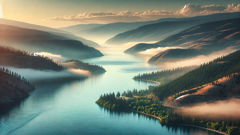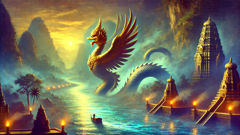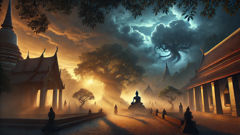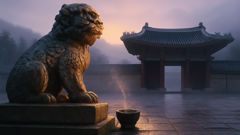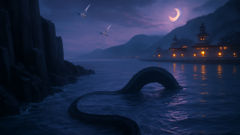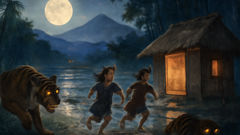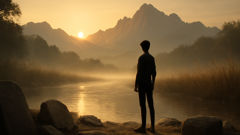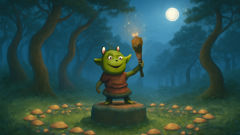Introduction
The Okanagan Valley stretches like a painter’s dream through the heart of British Columbia. In the early morning, the mist curls above the lake, pale and wispy, as if whispering secrets only the water remembers. The forests on the slopes glimmer with dew and the rugged mountains stand sentry in the dawn light. Generations have stood on these shores, looking out over the glassy blue, wondering about the stories that ripple just beneath the surface. For Okanagan Lake is more than just a breathtaking sweep of water; it’s the home of a legend, a mystery that has shaped the land and its people for centuries—the Ogopogo. Some call it a monster, others a spirit or guardian. Its name is sung in folk ballads, painted on murals, whispered between children at twilight. The lake is ancient, its depths carved by glaciers long before memory. Here, Indigenous Syilx people have lived for millennia, telling tales of a powerful being they call N’ha-a-itk, the water demon who commands respect and demands offerings. Colonists who arrived in the 19th century brought their own fears, weaving them into the growing tapestry of myth. Over the years, the story of the Ogopogo has grown, shifting with each new telling—sometimes terrifying, sometimes protective, always present. Sightings flicker through the local news: a long dark shape slipping beneath the water, waves with no wind, a feeling of being watched from the depths. Skeptics explain it away—just sturgeon, logs, tricks of the light. But those who’ve lived near Okanagan Lake know there’s something more. The legend has a heartbeat, one that pulses through the very landscape. As the valley wakes to another summer, three lives will converge on these storied shores: a scientist searching for proof, an Indigenous storyteller determined to honor tradition, and a skeptical journalist seeking the truth. Together, they’ll embark on a journey that will reveal not just the secrets of the lake, but the deeper truths that bind us to place, to history, and to each other.
Whispers Beneath the Water
The day began with the soft hush of paddles dipping into the lake. Dr. Evelyn Sinclair steadied her canoe, gaze fixed on the horizon, the surface of Okanagan Lake gleaming like a mirror. Her hands were calloused from years of fieldwork, and her heart beat faster every time she came here, driven by both scientific curiosity and a secret longing for something unexplainable. Every summer for the past five years, Evelyn had returned, armed with sonar equipment, waterproof notebooks, and a head full of legends. The Ogopogo had haunted her dreams since childhood, when her grandfather—who’d grown up Syilx—told stories by firelight of N’ha-a-itk, the spirit of the deep. He’d spoken in reverent tones of the need to respect the lake and its guardian, to make offerings before any crossing. At university, Evelyn had found only skepticism, dismissals, and the demand for evidence. She was determined to bridge those worlds: belief and science.
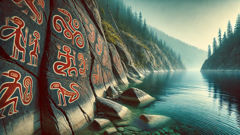
This morning was different. The water was eerily still, save for an inexplicable trail of ripples stretching across the bay. Evelyn set her sensors and let the silence settle. Far off, she spotted a figure standing on the shore—a tall man in a red woven vest, dark hair pulled back, watching her with a measured calm. She recognized him: Samuel Baptiste, respected Elder and keeper of Okanagan oral traditions. Samuel had agreed, reluctantly, to help with her research, provided she honored the protocols his ancestors had followed for centuries.
As she paddled ashore, Samuel greeted her with a nod. “You felt it too, didn’t you?” he asked, voice soft but sure. Evelyn smiled. “Maybe it’s just nerves. Or maybe there’s something here.”
“Everything here has spirit,” Samuel replied. He knelt at the water’s edge, scattering a handful of sage into the lake. “We ask permission, offer thanks. N’ha-a-itk isn’t just a story—it’s memory. The land remembers.”
Evelyn knelt beside him. “I respect that. My equipment can record, but it can’t feel.”
They worked together through the morning, lowering hydrophones into the depths. The equipment clicked and hummed, sending back images of schools of fish and tangled logs, but now and then, strange echoes appeared—long, undulating shapes that didn’t fit anything Evelyn had cataloged.
Midday brought heat and a crowd. Word had spread about Evelyn’s project, and a small knot of onlookers gathered at the dock. Among them was Lena Hart, a freelance journalist from Vancouver, notebook ready, skepticism etched into her brow. She approached with practiced ease. “You’re the monster hunters?”
Samuel’s eyes twinkled. “Not monsters. Keepers. Protectors.”
Evelyn showed Lena the equipment, explaining the science behind sonar imaging. Lena listened politely but pressed for evidence. “Have you seen it? Really?”
Samuel answered first. “I have seen what you would call Ogopogo, but not with these eyes.” He tapped his chest. “With these.”
Lena looked unconvinced but agreed to join their next excursion. Together, they pushed off in the canoe that afternoon—Evelyn at the bow, Samuel at the stern, Lena wedged between a stack of notebooks and a cooler of water. The lake shimmered, sunlight painting the hills in gold and green.
They glided over deep water where the color shifted from blue to an almost inky black. Samuel spoke softly, telling stories of the early Syilx people, their respect for the water, and the dangers of arrogance. “The first travelers who ignored the spirit paid dearly,” he said. “Storms would come from nowhere. Boats would vanish. The spirit is not cruel—it is balance.”
Halfway across, the hydrophone began to register a low, thrumming sound—far below human hearing, but powerful enough to send ripples through the boat. Evelyn checked her readings, frowning. “That’s not a motor. It’s… alive.”
The water around them quivered. Lena leaned over the edge, eyes wide as a long shadow moved beneath the hull—massive, sinuous, impossibly fast. For a moment, all three sat frozen.
The shadow vanished. The lake stilled. Lena caught her breath, pen forgotten. Samuel murmured a prayer.
As they returned to shore, Evelyn’s mind raced with possibilities. Was it a giant sturgeon? An undiscovered species? Or something beyond explanation? Lena, once skeptical, was silent, replaying the moment in her mind. Samuel’s gaze lingered on the water, a small smile playing on his lips. “You have seen the edge of the story,” he said quietly. “But the story is much deeper.”
The sun dipped behind the mountains, casting long shadows across the lake. Whatever they had witnessed, it was only the beginning.
Reckoning with the Past
Over the next several days, Evelyn, Samuel, and Lena found themselves drawn into a rhythm dictated by the moods of the lake. Each morning began with ritual—Samuel scattering sage, Evelyn calibrating sensors, Lena scribbling observations. The valley was alive with birdsong and the subtle movement of deer in the undergrowth, but their focus remained fixed on the water.
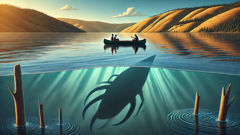
Word of their encounter spread through the small lakeside towns. Some locals scoffed—“It’s just a log, or a big fish.” But others approached with quiet seriousness, sharing their own stories: fishermen who’d seen wakes with no boats, elders who recalled warnings from their grandparents, children whose drawings depicted serpentine shapes rising from blue depths. For the Syilx community, the legend was not mere superstition; it was a living thread connecting present to past, land to spirit.
One morning, Samuel invited Evelyn and Lena to a gathering at the Westbank First Nation cultural center. They were greeted by murals of the lake and its guardian—painted in rich earth tones, scales shimmering with iridescent greens and blues. A circle of Elders shared stories as sage smoke drifted through the hall.
An Elder named Mavis told of an ancestor who tried to cross the lake without offering respect to N’ha-a-itk. “He was proud, thought he didn’t need spirit’s blessing. The water rose up and swallowed his canoe. Only his paddle returned to shore.”
Lena was fascinated. “Do you believe it’s real?” she asked Mavis.
Mavis smiled. “The lake remembers. Whether you believe or not, the spirit is here.”
The scientific part of Evelyn’s mind wanted data—measurements, proof. Yet every night she dreamt of the shadow moving beneath her canoe, felt the weight of unseen eyes watching from the depths. She began to question what ‘real’ truly meant.
They returned to the water with new resolve. Lena recorded interviews with townsfolk who recounted encounters both terrifying and awe-inspiring. Evelyn adjusted her equipment to capture broader frequency ranges, hoping to isolate the mysterious vibrations. Samuel guided them to ancient pictograph sites along rocky shores—red ochre images of long, snake-like creatures entwined with human figures.
One afternoon, a sudden summer storm swept in without warning. The sky darkened, wind howled, and waves slammed their small boat. Samuel’s voice rose above the roar as he chanted a song of protection, and Evelyn clung to her hydrophone as if it were a lifeline. In those moments, fear was primal; the lake became immense and unknowable.
They survived, drenched and shaken. That night by the campfire, Lena voiced what they all felt: “It’s like the lake has moods. Like it’s alive.”
Samuel nodded. “It is alive. All things have spirit. When you forget, you risk everything.”
Evelyn shared her latest sonar image: a faint but undeniable outline—something long and sinuous, with a head that flared like an oar blade. “It’s there,” she whispered.
The next day brought a new visitor: Dr. Mathias Grant, a respected ichthyologist who had publicly dismissed the Ogopogo as fantasy. He arrived with a camera crew and a confident stride. “Let’s see what all the fuss is about,” he said, shaking Evelyn’s hand with just a hint of condescension.
They set out together, cameras rolling. As they reached the deep channel in the center of the lake, Mathias explained his theory: “Most likely, we’re dealing with a population of large sturgeon or eels. Perfectly ordinary.”
Suddenly, the hydrophone picked up that low vibration again—stronger this time. Evelyn’s equipment registered a massive moving object at sixty meters depth. The surface roiled. The camera crew gasped as a dark shape broke through the water: a smooth, dark back arched for a moment before vanishing again, leaving only a swirl of foam.
Mathias was speechless. The footage would later make headlines across Canada: not a monster, but something undeniably real and unexplained.
Samuel watched it all with quiet satisfaction. “You’ve seen a shadow,” he told Mathias. “But have you listened to its story?”
That night, Evelyn sat alone by the shore. She thought about her grandfather, about science and spirit, proof and belief. She realized that the legend of the Ogopogo was less about what lived in the water and more about how we live with mystery—how we honor what we cannot fully understand.
Conclusion
As summer waned, Okanagan Lake shimmered in late afternoon sun, its secrets intact beneath rippling blue. Evelyn packed her equipment with care, but she left something behind: certainty. She’d gathered evidence, true—a parade of sonar images, strange sounds, even fleeting glimpses of something vast moving through the depths. But what lingered was less the thrill of discovery than a deepening respect. Samuel’s words echoed in her heart: all things have spirit; the lake remembers. Lena’s articles, once skeptical, now wove science and story together, her voice carrying both awe and humility. The footage they’d captured became the subject of heated debate across the country—was it a new species, or just an old log? But those who called Okanagan home knew that the real power of the Ogopogo legend lay not in proof but in presence. The tale endured because it reminded everyone that some mysteries are meant to be lived with, not solved—that wonder can bind communities, inspire respect for nature, and spark hope in uncertain times. And so, as dusk painted gold across the water and the first stars appeared above the valley, Evelyn, Samuel, and Lena sat together by the shore. They watched the lake grow still and silent, knowing that just beneath the surface, the guardian moved as it always had—invisible, enigmatic, eternal.

